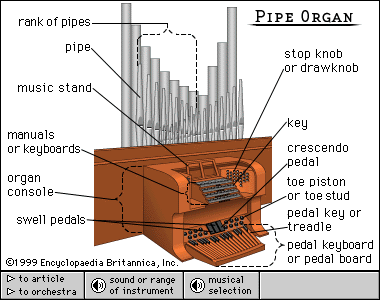Type of instrument: wind instrument with a keyboard
Materials used to make it:
Pipe organs are primarily made of wood and metal. Wood used to make parts of the organ which are not visible, such as the action, may be made of plywood or soft woods such as poplar. Visible wooden parts, such as the console, are made from hard, decorative woods, such as mahogany or oak. Wood is also used to make some of the pipes. Woods used for pipes include poplar and mahogany.
Most pipes are made from metal. Metal pipes are most often made from alloys containing various amounts of tin and lead. Pipes may also be made from other metals, such as zinc and copper. The vibrating reeds inside reed pipes are usually made of brass.
Various small components, such as screws and bolts to hold parts of the action together, are made of steel. Other small components may be made of other materials, such as plastics and ceramics. Electronic organs require semiconducting materials, such as silicon and germanium, in order to manufacture the electrical circuits which produce the sound.


